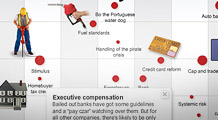No end in sight for bank bailouts
Even as the industry recovers, winding down last year's rescue programs and new ones put in place by the Obama administration may be easier said than done.
 |
| The S&P Banking Index, a key measure of bank stocks, has rebounded sharply since March following a brutal start to the year. |
NEW YORK (CNNMoney.com) -- After rescuing the nation's banking system from utter disaster last fall, Washington now faces an arguably much trickier task: putting the bailout genie back in the bottle.
Several initiatives are on course to expire later this year, putting regulators and the White House in the difficult position of having to decide whether the nation's banking industry is strong enough to go it alone.
"They would love to get out of the middle of all this stuff if they could," said John Douglas, a former general counsel at the Federal Deposit Insurance Corp, who now heads the banking regulatory practice at law firm Davis Polk & Wardwell. "The question really is whether the financial system and capital system is vibrant enough to exit without a government backstop."
So far, most of the signs from the banking industry lately have been somewhat encouraging.
The credit markets seem to be returning to normal. The London Interbank Offered Rate -- or Libor -- a widely relied upon measure of bank-to-bank lending rates, is now well below the record high it hit after Lehman Brothers filed for bankruptcy last fall.
At the same time, most banks are back in the black. Even embattled lenders Citigroup (C, Fortune 500) and Bank of America (BAC, Fortune 500), both of which were widely believed to be on the verge of being seized by the federal government earlier this year, managed to report their second consecutive quarter of profits in the latest quarter.
Of course, much of the financial crisis has been defined by false bottoms, with investors thinking that the worst was over, only to face a more severe scenario just months later.
Mostly for that reason, experts think that the programs that helped resolve some of the vicious liquidity issues banks were facing last fall might live on for several more months.
"You don't want to take off a program and have the world end immediately afterward," said Mark J. Flannery, a professor of finance at the University of Florida's Warrington College of Business Administration.
The FDIC's Temporary Liquidity Guarantee Program, or TLGP, which regulators have been angling to wind down by the end of October, is one program that might be extended.
The TLGP, which guarantees debt issued by banks and ultimately allows them to borrow from the public market at a discounted rate, still remains quite popular even as some large institutions have started to wean themselves off it.
Through June, the running total of outstanding guaranteed bank debt stood at $277 billion, $50 billion more than when the program first started last November.
Looming troubles in the commercial real estate market have also prompted some lawmakers to push the Federal Reserve to extend its Term Asset-Backed Securities Loan Facility, or TALF, through 2010. That program, which was designed to rekindle the securitization market by providing cheap financing to investors, is set to end on Dec. 31.
Last week, Rep. Paul Kanjorski, D-Pa., who chairs a key House Financial Services subcommittee, along with 40 other members of Congress, urged the central bank to give the program more time to help bridge the $1 trillion in commercial real estate coming due and prevent a massive loss of jobs.
"While I would like to wind down the government's emergency support for the private sector as quickly as possible, we need to provide more time for the TALF program to work in this [commercial real estate] industry," Kanjorski wrote in a letter to the Fed and Treasury Department.
Other more recent proposals, such as the Treasury Department's Public-Private Investment Program, will also need more time to work. The PPIP, which was beset by multiple delays as regulators tried to figure out the best means of removing many of the troubled assets from banks' books, is still not up and fully running yet.
Finally, Treasury still holds billions of dollars worth of preferred share stakes in hundreds of banks under the Troubled Asset Relief Program, or TARP.
Even as some financial firms have exited that controversial program, some strained institutions may have little choice but to retain the government's investment through the 2012 repayment deadline.
The persistence of TARP and various other programs, however, will hardly change the American public's perception that the government is continuing to bail out corporate America.
Mark Calabria, director of financial regulation studies at the Cato Institute, a Washington-based think tank that promotes libertarian views, notes that President Obama is already acutely aware of the stigma that many of these programs carry with them -- especially among taxpayers.
So while banking regulators may have the final say on which rescue plans stay and which ones go, Calabria said the White House will probably be offering its own suggestions behind the scenes.
"I think the president is very much aware that at some point he can't keep saying it was all George W. Bush," said Calabria. "I think there is unwillingness on the part of the administration to associate itself with continuing bailouts."
Talkback: How would you grade the Obama administration's efforts to help fix the nation's banking system? Share your comments below. ![]()


